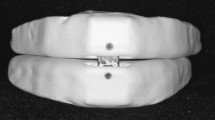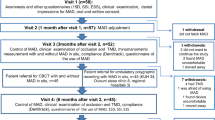Abstract
The aim of the study was to assess the influence of four mandibular protrusion positions, at a constant vertical dimension, on obstructive sleep apnea (OSA). Seventeen OSA patients (49.2 ± 8.5 years) received an adjustable mandibular advancement device (MAD). The patients underwent four polysomnographic recordings with their MAD in situ at, in random order, 0%, 25%, 50%, and 75% of the maximum protrusion. The mean apnea–hypopnea index (AHI) values of the patients differed significantly between the protrusion positions (P < 0.000). The 25% protrusion position resulted in a significant reduction of the AHI with respect to the 0% position, while in the 50% and 75% positions, even lower AHI values were found. The number of side effects was larger starting at the 50% protrusion position. We therefore recommend coming to a weighted compromise between efficacy and side effects by starting a MAD treatment in the 50% protrusion position.


Similar content being viewed by others
References
Aarab G, Lobbezoo F, Wicks DJ, Hamburger HL, Naeije M (2005) Short-term effects of a mandibular advancement device on obstructive sleep apnoea: an open-label pilot trial. J Oral Rehabil 32:564–570
American Academy of Sleep Medicine Task Force (1999) Sleep-related breathing disorders in adults: recommendations for syndrome definition and measurement techniques in clinical research. Sleep 22:667–689
Cartwright RD (1984) Effect of sleep position on sleep apnea severity. Sleep 7:110–114
Dworkin SF, LeResche L (1992) Research diagnostic criteria for temporomandibular disorders: review, criteria, examinations and specifications, critique. J Craniomandib Disord 6:301–355
Engleman HM, McDonald JP, Graham D, Lello GE, Kingshott RN, Coleman EL, Mackay TW, Douglas NJ (2002) Randomized crossover trial of two treatments for sleep apnea/hypopnea syndrome: continuous positive airway pressure and mandibular repositioning splint. Am J Respir Crit Care Med 166:855–859
Ferguson KA, Cartwright R, Rogers R, Schmidt-Nowara W (2006) Oral appliances for snoring and obstructive sleep apnea: a review. Sleep 29:244–262
Fritsch KM, Iseli A, Russi EW, Bloch KE (2001) Side effects of mandibular advancement devices for sleep apnea treatment. Am J Respir Crit Care Med 164:813–818
Gagnon Y, Mayer P, Morisson F, Rompré PH, Lavigne GJ (2004) Aggravation of respiratory disturbances by the use of an occlusal splint in apneic patients: a pilot study. Int J Prosthodont 17:447–453
George PT (2001) Selecting sleep-disordered-breathing appliances: biomechanical considerations. J Am Dent Assoc 132:339–347
Giles T, Lasserson T, Smith B, White J, Wright J, Cates C (2006) Continuous positive airways pressure for obstructive sleep apnoea in adults. Cochrane Database Syst Rev Issue 3:CD001106
Gotsopoulos H, Chen C, Qian J, Cistulli PA (2002) Oral appliance therapy improves symptoms in obstructive sleep apnea: a randomized, controlled trial. Am J Respir Crit Care Med 166:743–748
Hoekema A, Stegenga B, de Bont LG (2004) Efficacy and co-morbidity of oral appliances in the treatment of obstructive sleep apnea–hypopnea: a systematic review. Crit Rev Oral Biol Med 15:137–155
Hoffstein V (2007) Review of oral appliances for treatment of sleep-disordered breathing. Sleep Breath 11:1–22
Holm S (1979) A simple sequentially rejective multiple test procedure. Scand J Statist 6:65–70
Johns MW (1991) A new method for measuring daytime sleepiness: the Epworth sleepiness scale. Sleep 14:540–545
Johns MW (1993) Daytime sleepiness, snoring and obstructive sleep apnea: the Epworth sleepiness scale. Chest 103:30–36
Kato J, Isono S, Tanaka A, Watanabe T, Araki D, Tanzawa H, Nishino T (2000) Dose-dependent effects of mandibular advancement on pharyngeal mechanics and nocturnal oxygenation in patients with sleep-disordered breathing. Chest 117:1065–1072
Kushida CA, Morgenthaler TI, Littner MR, Alessi CA, Bailey D, Coleman J Jr, Friedman L, Hirshkowitz M, Kapen S, Kramer M, Lee-Chiong T, Owens J, Pancer JP, American Academy of Sleep (2006) Practice parameters for the treatment of snoring and obstructive sleep apnea with oral appliances: an update for 2005. Sleep 29:240–243
Lobbezoo F, van Selms MK, John MT, Huggins K, Ohrbach R, Visscher CM, van der Zaag J, van der Meulen MJ, Naeije M, Dworkin SF (2005) Use of the research diagnostic criteria for temporomandibular disorders for multinational research: translation efforts and reliability assessments in The Netherlands. J Orofac Pain 19:301–308
Lowe AA, Sjöholm TT, Ryan CF, Fleetham JA, Ferguson KA, Remmers JE (2000) Treatment, airway and compliance effects of a titratable oral appliance. Sleep 23:S172–S178
McArdle N, Devereux G, Heidarnejad H, Engleman HM, Mackay TW, Douglas NJ (1999) Long-term use of CPAP therapy for sleep apnea/hypopnea syndrome. Am J Respir Crit Care Med 159:1108–1114
Meurice JC, Marc I, Carrier G, Sériès F (1996) Effects of mouth opening on upper airway collapsibility in normal sleeping subjects. Am J Respir Crit Care Med 153:255–259
Miyamoto K, Ozbek MM, Lowe AA, Sjöholm TT, Love LL, Fleetham JA, Ryan CF (1999) Mandibular posture during sleep in patients with obstructive sleep apnoea. Arch Oral Biol 44:657–664
Morin CM (2005) Psychological and behavioral treatments for primary insomnia. In: Kryger MH, Roth T, Dement WC (eds) Principles and practice of sleep medicine, 4th edn. Saunders, Philadelphia, pp 726–737
Neill A, Whyman R, Bannan S, Jeffrey O, Campbell A (2002) Mandibular advancement splint improves indices of obstructive sleep apnoea and snoring but side effects are common. N Z Med J 115:289–292
Ng AT, Gotsopoulos H, Qian J, Cistulli PA (2003) Effect of oral appliance therapy on upper airway collapsibility in obstructive sleep apnea. Am J Respir Crit Care Med 168:238–241
Rechtschaffen A, Kales A (1968) A manual of standardized terminology, techniques and scoring systems for sleep stages of human subjects. Brain Information Service/Brain Research Institute, UCLA, Los Angeles
Roehrs T, Carskadon MA, Dement WC, Roth T (2005) Daytime sleepiness and alertness. In: Kryger M, Roth T, Dement WC (eds) Principles and practice of sleep medicine. Elsevier, Amsterdam, pp 39–50
Strollo PJ, Atwood CW, Sanders MH (2005) Medical therapy for obstructive sleep apnea–hypopnea syndrome. In: Kryger MH, Roth T, Dement WC (eds) Priniciples and practice of sleep medicine, 4th edn. Saunders, Philadelphia, p 1053
Tegelberg A, Walker-Engström ML, Vestling O, Wilhelmsson B (2003) Two different degrees of mandibular advancement with a dental appliance in treatment of patients with mild to moderate obstructive sleep apnea. Acta Odontol Scand 61:356–362
Walker-Engström ML, Ringqvist I, Vestling O, Wilhelmsson B, Tegelberg A (2003) A prospective randomized study comparing two different degrees of mandibular advancement with a dental appliance in treatment of severe obstructive sleep apnea. Sleep Breath 7:119–130
Acknowledgments
The authors would like to thank the staff of the Center for Sleep–Wake Disorders of Slotervaart Medical Center in Amsterdam, The Netherlands for their assistance with this work. The Netherlands Institute for Dental Sciences (IOT) supported this work.
Conflict of interest
All authors declare that they have no conflict of interest in this study.
Author information
Authors and Affiliations
Corresponding author
Rights and permissions
About this article
Cite this article
Aarab, G., Lobbezoo, F., Hamburger, H.L. et al. Effects of an oral appliance with different mandibular protrusion positions at a constant vertical dimension on obstructive sleep apnea. Clin Oral Invest 14, 339–345 (2010). https://doi.org/10.1007/s00784-009-0298-9
Received:
Accepted:
Published:
Issue Date:
DOI: https://doi.org/10.1007/s00784-009-0298-9




